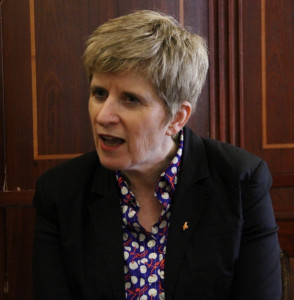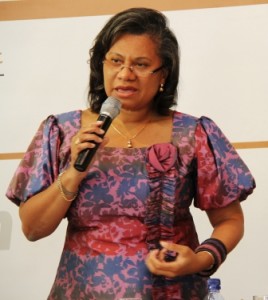As a psychologist working in an HIV programme at the University of Pretoria, South Africa, I have [...]]]>
As a psychologist working in an HIV programme at the University of Pretoria, South Africa, I have counselled many students about sex over the years. Many of these students lack confidence, comfort and literacy around sex that empowers rather than embarrasses them.
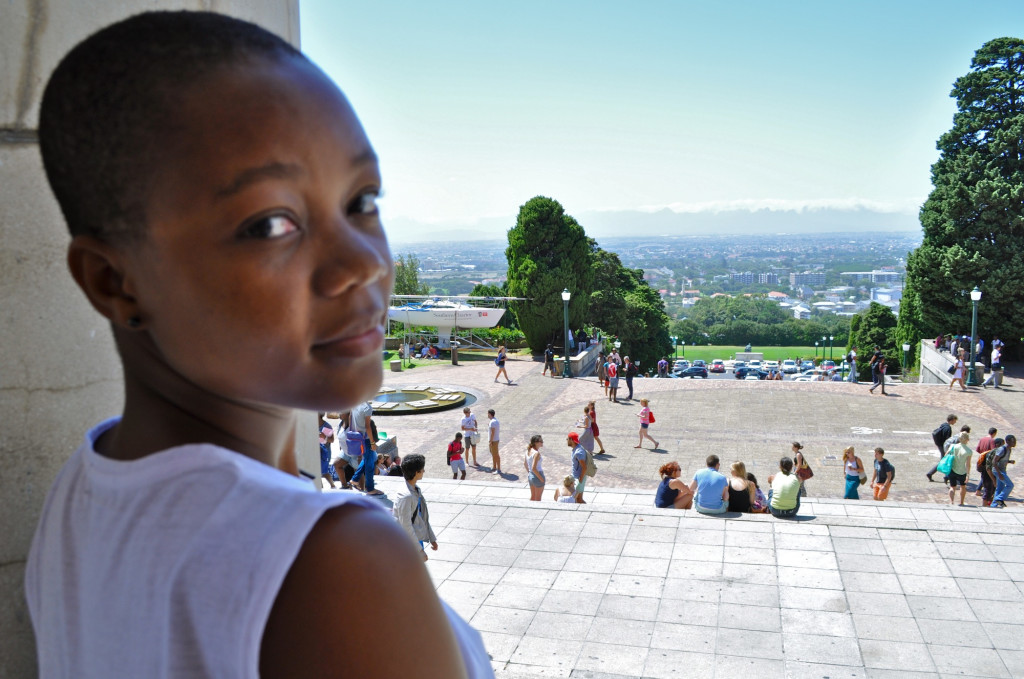
While a university cannot be all things to all people, it can promote the idea that everyone has a right to sex that is healthy and mutually enjoyable. Credit: Rebekah Funk/IPS
Despite living in a country where an early sexual debut is not unusual, where sexual assault and rape are endemic, and where surveys show university students are having sex and sometimes contracting HIV, we seem to think that if we control, manage and inhibit the sexuality of young people, we will somehow keep them from harm until that magical day when they meet their similarly abstinent and “pure” life partner, releasing them into each other’s arms for a life of wonderful, safe, healthy and faithful sex.
This ambivalence about young people’s sexuality is evident in the response of the state. Yes, we have, on paper at least, an excellent Life Orientation programme in schools.
But while there are pockets of excellence and dedication, often the work is done by teachers who are not well motivated or trained, who themselves struggle with their own relationships and sexuality, and who are often quite conservative about sexual norms and different sexual orientations.
Coexisting paradigms
This awkwardness about youth sexuality carries over into many university spaces and programmes where different paradigms co-exist, each with its own challenges and possibilities.
Many campus health programmes, not surprisingly, adopt a public health approach: seeing students as rational actors who, if given the correct health information and warnings about disease, HIV and pregnancy, will simply choose not to have sex, or if they must, will use condoms and contraceptives all the time.
While students may be given tests and access to contraception, and sometimes even the morning after pill, a sense of a finger wagging goes along with these technologies.
Yet the language of disease, risk and infection runs counter to the experience of desire, pleasure, transgression and power, which drives many sexual encounters.
The public health approach often fails to factor in these elements – less amenable to rational thinking – and glosses over the relationality of sex; meaning that we make decisions, some conscious, some less so, based on the dynamics of the moment and the person we are with.
Another paradigm is the idea that the university “stands in” for the parents of the student, setting boundaries and limits to sexual expression, perhaps even invoking the language of morality, to define the kind of sexual citizen the student is expected to be: preferably abstinent, hopefully faithful and definitely heterosexual.
Evidence for this: constrictions on sexual expression in residences, attitudes towards pregnancy and abortion, the privilege given to religious voices on some campuses, and the use of parental titles in residences (house mothers and fathers).
Paradoxically, the free availability of alcohol and inadequate approaches to understanding and managing drug use, complicate this picture, placing more pressure on universities to control sex and sexual expression, and act as parent figures.
Sexual competence
The most hopeful approach, in my view, is the sexual competence one developed by British sociologist, Julia Hirst.
Sexual competence means being able to negotiate sex that is safe (both in terms of disease and in terms of the physical space it occurs in) and mutual, by people with a positive sense of their sexual selves and identities.
It does not assume heterosexuality or privilege vaginal penetration, recognising that we all need a repertoire of ways to give and receive pleasure.
To be sexually competent means having a confident and fluent language for sex; it values personal feelings of control in decision making. It can also mean being fully comfortable in saying no to sex, not from a position of fear and shame, but from a place of recognition of what one really wants.
In my years as a psychologist, I have worked with many adults who have unhappy and complicated sex lives. Young people need not follow this path.
While a university cannot be all things to all people, it can promote the idea that we all have a right to great sex which is equal and not exploitative, which is healthy and mutually enjoyable.
To achieve this, universities need to get real and be open to new conversations with and about their students’ sexual cultures, identities and practices.
Pierre Brouard, director of the Centre for the Study of AIDS at the University of Pretoria, South Africa, is a clinical psychologist interested in sexualities, gender, human rights, and finding just the right word to grace a sentence, convey empathy or complete a crossword.
]]>Gilmore discussed the impact on African youth of the last two decades of action on sexual and reproductive health and equal access to education [...]]]>
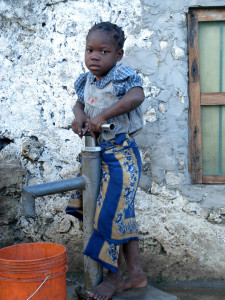
Credit: Mercedes Sayagues/IPS
“The future is today aged 10 and it’s an adolescent girl,” Kate Gilmore, deputy executive director of the United Nations Population Fund (UNFPA), said in an interview with IPS in Johannesburg.
Gilmore discussed the impact on African youth of the last two decades of action on sexual and reproductive health and equal access to education for girls, which are assessed in the International Conference on Population and Development (ICPD) Beyond 2014 Global Report.
The report was released on Feb. 12, the anniversary of the 1994 ICPD, where 176 countries agreed on a 20-year Programme of Action, also known as the Cairo Consensus. This is a good opportunity to assess the gains and challenges of the ICPD, said Gilmore.
Q: What has the global community achieved for young people in the last 20 years?
A: One of the really groundbreaking outcomes of the ICPD was the commitment to sexual and reproductive health, making it a human rights project and not a population control project, not a project about controlling women’s fertility but a project about empowering women to be in charge of their bodies. It was a really cool shift that created transformation in public policy.
The past 20 years has also seen 1,2 billion people lifted out of poverty, a 42 percent decline in maternal mortality, and 90 percent of children passing through primary school.
Q: What economic gains have been made in Africa?
A: We have not made much economic gains in terms of addressing disparities.The gap between the rich and poor has gotten bigger within countries and between countries.
The data we were able to examine, covering the period between 2000 and 2008, just before the most recent economic crisis, showed the world had experienced and benefited from economic growth. But 50 percent of the economic growth went to less than five percent of the world’s population and economic growth gave no benefit to ten percent of the world’s population, who are the poorest.
UNFPA is calling on Member States to commit to legislative and policy reform that says there is no place for inequality, discrimination and marginalisation in our society.
Q: HIV prevalence in adolescent girls has not decreased in the past 20 years. Has the ICPD failed adolescent girls in this regard?
A: Yes, but this is a shared failure, because states also have a responsibility. We have failed to protect our girls from early marriage, from gender based violence and from early pregnancies. Governments need to realise that, unless we change the trajectory of adolescent girls on their journey to adulthood, there will be no development that is more sustainable, inclusive and resilient.
When you change the trajectory of the adolescent girl, everything changes in a community. Looking at all the data from the past 20 years, we can see clearly that what happens to the adolescent girl in the next 15 years, that is what will make or break the future.
Q: How do we invest in young people?
A: By engaging with governments and saying, let us have a look at your national strategies and priorities, let us give you access to the best technical wisdom. We also look into the best way to get the best benefit from having a healthy young population: changing health systems, improving education systems, creating spaces for young people to hone their entrepreneurial skills in new sectors.
Q: How has Africa addressed adolescent sexual and reproductive health?
A: Through deliberations of the African Union, we have seen increasing attention to sexual and reproductive health and rights. However, I do believe it has not always been identified as a young person’s issues. But, as governments have become sophisticated in the analysis of demographic realities, it has become clearer that when we talk about maternal mortality, HIV and AIDS, unsafe abortion, early marriage, fistula, and female genital mutilation, we are talking about young people.
Q: Why is it important to address the youth bulge in Africa?
A: Africa is a young person’s continent. The median age in most countries is 30 years and in Africa it is 20 years. If you want to make the youth cohort the fuel for driving economic prosperity, social stability and good governance, give them access to education and keep them healthy.
]]>
** Dr. Julitta Onabanjo is the Regional Director for UNFPA’s East and Southern Africa region, stationed in Johannesburg
Recently, a 14-year-old girl from Kakamega County in Kenya gave birth to a set of triplets, fathered by a boy aged 16. The phenomenon of children having babies is not limited to Kenya; it occurs [...]]]>
** Dr. Julitta Onabanjo is the Regional Director for UNFPA’s East and Southern Africa region, stationed in Johannesburg
Recently, a 14-year-old girl from Kakamega County in Kenya gave birth to a set of triplets, fathered by a boy aged 16. The phenomenon of children having babies is not limited to Kenya; it occurs in many African countries.
Fifteen-year-old Ida, from Mozambique, became pregnant when she was 13 years old while 25-year-old Mariel, from Madagascar, got pregnant when just 13 years.
Each year, 7.3 million girls under the age of 18 give birth in developing countries — of these, around 2 million are under 15.
As an African mother, I would not like my daughter, or niece – or any young girl, for that matter – to get pregnant at an early age, not just because it would compromise their life opportunities, but also because medically and psychologically, teenage pregnancy poses high risk for both the adolescent girl and her child.
The trend of children giving birth to children should not be allowed to continue. This is why UNFPA’s State of World Population 2013: Motherhood in Childhood, launched this week, addresses the challenge of adolescent pregnancy head on.
The social drivers of adolescent pregnancy in our society are well known. They include impoverishment, social marginalization and child marriage. Others are limited choices and opportunities in life, or inadequate access to sexual and reproductive health, including contraceptive information and services.
As the report notes, “Every day, 20,000 girls below age 18 give birth in developing countries,” most of them from lower-income rural households. Many of these girls are also nutritionally deficient.
Pregnancy has enormous consequences for a young girl. Broadly speaking, it alters the course of her life, seriously affecting her health, education and income-earning potential.
Pregnancy and childbirth are the leading cause of death for adolescent females in developing countries, resulting in 70,000 deaths annually. Likewise, health problems such as obstetric fistula are more likely if a girl becomes pregnant too soon after reaching puberty.
When girls leave school due to pregnancy or for any other reason, their economic prospects are jeopardised, while their opportunities in life might be severely truncated.
A call to action
Thus, addressing motherhood in childhood requires institutional and community responses, as well as individual commitment. Programmes that target the girl child need to take into account the broader social drivers of the problem.
For instance, we need to address the underlying factors of adolescent pregnancy, including gender inequality, poverty, sexual violence and coercion, child marriage, social pressures, exclusion from education and lack of job opportunities. We must also address the negative attitudes and stereotypes about adolescent girls that contribute to the problem.
An important area of concern is inadequate access to comprehensive sexuality education and youth friendly information and services where their privacy and confidentiality is maintained. Teenagers need to be fully informed on how to protect themselves from unplanned pregnancies.
Adolescents and young people also need holistic development, which focuses on creating a safe and supportive environment for accessing information, services and platforms for participation and advocacy.
Communities, including religious and traditional leaders, school authorities and social protection officers should work to protect the rights of girls in teen pregnancy and child marriage. This is where some of the conditions, norms, values and structures that perpetuate adolescent pregnancies can be changed.
Specifically, our boys and men should respect the rights of adolescent girls and not cajole or coerce them into sex. It is absolutely critical that our young people are enabled to protect themselves against sexually transmitted infections, especially HIV – the second main cause of death among young women in Africa.
And as so many adolescent girls die from unsafe abortions when choosing to terminate their unplanned pregnancies, they must be granted access to modern contraceptive and safe abortion services.
All said, our children should not be having babies. It is our collective duty to ensure that adolescent and young people achieve their full potential through quality education, health information and services, gainful employment and being protected from unplanned pregnancies and child marriage.
Now is the time to harness and invest into the resilience of our young people to achieve great dividend for the African continent.
]]>A. When it is shown in a pornographic magazine, film or website.
B. Never.
C. When it is emailed to government officials urging action to improve public health.
One could argue about A and B but this blog is [...]]]>

By Paula Modersohn Becker
When is a photo of a woman giving birth considered pornographic? Take your pick:
A. When it is shown in a pornographic magazine, film or website.
B. Never.
C. When it is emailed to government officials urging action to improve public health.
One could argue about A and B but this blog is about C.
Earlier this year, in Zambia, Chansa Kabwela, news editor at the feisty opposition newspaper The Post, was charged with circulating pornography with intent to corrupt public morals. What was her crime? During a nationwide strike by Zambia’s miserably paid doctors, a woman allegedly gave birth without medical assistance in a hospital car park. The baby was in a breech position and later died.
Her family sent Kabwela the photos but she found them too graphic for publication. Instead, she emailed them to the vice-president and other government officials and women’s groups, urging a negotiated end to the strike to avoid more deaths.
President Rupiyah Banda found the photos “morbid and peculiar” and Kabwela, a 29-year-old mother of two, was charged with the porn offence, which carries a five-year jail sentence. The state argued that giving birth is sacred in Zambia and the photos were disrespectful.
If giving birth is so sacred, why was the woman delivering in a car park?
Good sense prevailed and in November a judge acquitted Kabwela.
The Post has long been harassed by government for exposing corruption. This court case is one more instance, using birth, women and tradition as a cover to erode press freedom.
A very famous Christmas birth
This being the season of a famous birth, on the other side of the world, in New Zealand, a mischievous billboard about the immaculate conception has angered Catholics. 
It shows Joseph and Mary in bed. She looks blissful; he looks dejected. The kicker: “Poor Joseph. God is a hard act to follow.”
The twist is that the originator is an Anglican archdeacon who commissioned an ad agency to produce a Christmas poster. The archdeacon argues, somewhat confusedly, that the purpose was to highlight that Christmas is about love, not about Mary’s impregnation by God.
Within hours the billboard was defaced with brown paint. Well, at least this is better than rioting over caricatures of the Prophet or charging an editor with pornography.
Giving birth is charged with cultural meaning: it can be sacred, pornographic, joyful, “eculiar” or offensive. For half a million women, every year, it is deadly.
Yet these deaths do not spark the same outrage as a billboard or photographs.
My wish this Christmas is quite simple: safe delivery for women everywhere, not in a car park and not in a manger, neither holy nor unholy, whether through sex, artificial insemination or immaculate conception. Just safe.
***
Read about why maternal mortality remains so intractable here and about midwives in India.
]]>Yet CEDAW – Convention of the Elimination of All Forms of Discrimination Against Women – has likely impacted on her life and her daughters, if [...]]]>
Yet CEDAW – Convention of the Elimination of All Forms of Discrimination Against Women – has likely impacted on her life and her daughters, if she has any, in many ways, from pension and inheritance rights to the passport they hold.

Quilt made by women of Kyrgztan. (Unifem)
CEDAW, which was adopted by the United Nations General Assembly 30 years ago today, is the global Bill of Rights for Women, the first international human rights treaty devoted to gender equality.
Through its 30 articles, CEDAW has boosted women’s rights worldwide in many ways.
Some examples: new constitutional guarantees for women in Thailand; land- owning rights for women in Kyrgyzstan and Tajikistan; changes to the law of evidence to benefit women in the Solomon Islands; and reproductive health rights in Colombia.
India outlawed sexual harassment in the workplace, Mexico tightened its domestic violence laws and Morocco passed a new family code in 2004. Read more here.
Today CEDAW turns 30 and is the world’s most widely ratified treaty, with 186 signatory countries.
But there is no time to rest on laurels.
Attempts by conservative forces – from Washington to Jerusalem, from Riyadh to Jakarta – to erode CEDAW are underway, primarily in the field of women’s reproductive rights, nationality, family rights and relationships.
Several countries have failed to ratify the treaty – Iran, Nauru, Palau, Somalia, Sudan, Tonga and the United States, although the Obama administration has indicated it will.
Twenty-two countries have signed and ratified but reserve the right not to implement certain provisions.
Some are minor: Australia does not want to send women soldiers into combat.
Others are more threatening: the United Arab Emirates wants to keep its unequal inheritance laws based on Shariah, and Algeria, its Family Law.
Worldwide, the treaty’s implementation is uneven. In the Occupied Palestinian Territories, Palestinian women suffer abuse and denial of basic human rights at the hands of Israeli settlers and soldiers. The right to family reunification is particularly ignored.
Nevertheless, in three decades, CEDAW has truly changed the world for women, for those who fly on planes and for those who ride donkey carts alike. Equality is our right.
HAPPY ANNIVERSARY!
What had tongues wagging was citizen’s journalism, dispatches by ordinary folk about electoral irregularities from the Rovuma to the Maputo rivers.
Good stuff: government cars illegally used for campaigning, [...]]]>

The sisters can do it by themselves. By A. Vilanculos
The buzz in Mozambique during the recent elections was not the TV debate among presidential candidates debate (there is none) or their programs (all vague).
What had tongues wagging was citizen’s journalism, dispatches by ordinary folk about electoral irregularities from the Rovuma to the Maputo rivers.
Good stuff: government cars illegally used for campaigning, with cellphone pics of their registration plates (until officials wised up and started covering up plates and ministry logos with party posters). Reports of youth tearing downs other party’s posters, fistfights, intimidation, and police lack of impartiality.
On election day, people told of late opening of polling booths and misbehaviour of poll officials and party observers.
Information was relayed by a network of 110 correspondents in 11provinces (most community radio reporters) and concerned citizens who texted, phoned and emailed.
The information was fact-checked and collected in a daily bulletin produced by the Centro de Integridade Publica (an NGO anti-corruption monitor).
The bulletin, in Portuguese and English, was emailed as pdf to some 3,000 subscribers, who redistributed it to at least double this number, and was widely reproduced, for free, by the local press, especially the 60+ community radio stations.
This was watchdog citizen journalism at its best.
Thanks to the Bulletin, Mozambicans had balanced coverage of the pre-poll partial exclusion of the new kid in the block, the opposition MDM, of the instances of ballot box stuffing and the invalidation of 100,000 votes.
The Bulletin provided a credible, professional and impartial source of information, above party politics (Mozambican media is aligned with political parties, ideological blocs and economic interests).
Bits of similar projecst exist elsewhere in Africa but I don’t know of any other so well-rounded.
In Kenya, during the post-electoral conflict two years ago, people texted and phoned in reports of violence to a hotline set up by an enterprising NGO. The information was quickly confirmed and uploaded onto a web map. The press, donors, and people could keep tabs on which parts of Kenya were burning.
Ghana made good use of sms by citizen correspondents during its recent elections.
Imagine if women developed such a tool.
Imagine that the 50-50 Campaign for equal political representation in Malawi could track women candidates during the campaign and the polls, and keep tabs on the insults, the stone-throwing, and the intimidation of women candidates seen last year.
In South Africa, during the 15 days against Violence against Women that started this week, a daily bulletin could keep track of gender-based abuse, collecting reports from police, rape crisis centres, and shelters. This would provide a graphic picture of South Africa’s second epidemic, after AIDS.

Grab it now! Pic b y A. Vilanculos
Historically, women are the last to use new technologies. This time, we should grab it now!
Check the Take Back the Tech site for cool ideas on taking control of digital technology to end violence against women.
And not only digital – one idea I liked is to go for a walk with a chalk and write up your thoughts on public space.
Watch the sidewalks of my neighbourhood in Pretoria – have chalk and thoughts, will walk.
* Read IPS stories on femicide in Chile, forced sterilisation in Peru and gender-based violence elsewhere.
]]>I will call her Gabra (gift, in Amharic), for our conversation was private. I met her at a monastery near Lalibela, the mystical city of [...]]]>

Patriarchal in all senses. By M. Sayagues
What drives a 17-year-old girl to enter a monastery? Today she is 30, and still happy about her choice. Her eyes sparkle and her laughter comes easy. She exudes peace.
I will call her Gabra (gift, in Amharic), for our conversation was private. I met her at a monastery near Lalibela, the mystical city of rock-hewn churches in northern Ethiopia.
Monastic life has a long tradition and prestige in the Ethiopian Orthodox Church. The oldest monastery dates from the 6th century. A monastic renaissance between the 13th and 16th century brought great moral and political authority to clergy.

Custodians of tradition
Gabra’s rock-hewn monastery dates from the 12th century. Her room is excavated in the pink tufa rock. Two built-in-the-rock platforms, covered with a thin mattress, do as couch and bed. An old cupboard holds a few plates and cooking utensils, three of the long green robes worn by Ethiopian peasants, the white headscarves that nuns wear, and two pairs of sandals.
For income, she and her fellow nuns weave cotton and silk into diaphanous shawls, sold at the monastery. She rises before dawn to pray – the first of daily seven prayers. Her ambition is to study theology in Addis Ababa or in Lalibela.
Gabra is not completely cut off from the world. She has a cellphone and a radio. On Sundays, relatives and friends visit.
Choices
I ask her if marriage and children ever interested her.
“It is a privilege to be single and not to have children,” she says softly, smiling but firmly. She sounds relieved.
Unmarried myself, I agree that motherhood and marriage are just one option. I understand the spiritual call, the peace of contemplation and withdrawal, of a simple lifestyle unencumbered by material things.
Yet I wonder if female genital mutilation had to do with her decision.
In Ethiopia’s eastern region, a girl might suffer genital cutting between the age of 15-17, before marriage. Her clitoris would be cut, sometimes the labia.
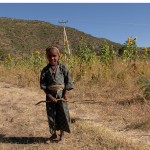
She has a right to her bodily integrity.
In Somali region, she would have infibulation at a younger age: the complete removal of her genitalia and, to preserve virginity, being stitched shut with an acacia thorn, leaving only a hole to urinate.
About three-quarters of women in Ethiopia between 15-49 have suffered some form of genital mutilation, said a government survey of 2005. The practice is fading – but too slowly, say activists.
It is not called mutilation for nothing. Sex and childbirth will be extremely painful and dangerous.
If finding a husband means suffering genital cutting, a hard mattress in a rock-hewn room is a much better place than a king-size wedding bed.
Gabra did not speak English, my male guide spoke little, and sex topics are taboo in Ethiopia, so the conversation went in another direction. Gabra was curious about my life, my work, and my daughter. 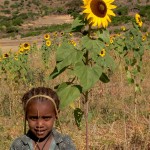
“Would you want to live like me?” she asked. “I don’t think I could,” I said. “But I feel the beauty of this simplicity.” She smiled.
Ethiopia looks and feels ancient and spiritual. Social cohesion is remarkable. But the same lifestyle that makes ferenji (foreigner, in Amharic) wax lyrical about the “biblical landscape and people” binds women to painful and dangerous traditions.
Some traditions are simply annoying. Women cannot join the rites if they are menstruating, ergo unclean. At no time of the month can women, local or foreign, enter the most sacred chapel of the Lalibela complex, Bete Mikael, where King Lalibela is buried. We are only allowed a glimpse from the door. In some monasteries, no females, including of the animal kingdom, are allowed.
Monastery visitors take leave at 5 PM (international time; in Ethiopian time, 11 in the night). I make my way down the stony path, the tufa rock glowing pink and gold in the sunset.
I am thinking that the monastery – the spiritual world – may be a blessed refuge from the hardship of being born female in a deeply patriarchal world.
Read recent IPS stories about genital cutting in Uganda, Sierra Leone and cross-border in West Africa.
]]>http://www.campaignforrealbeauty.ca/bblank.asp?id=6895
Digital cosmetic surgery – nip-and-tuck, botox and liposuction, on the screen, with a click – render these models picture-perfect (excuse the pun) and thoroughly unreal.
There [...]]]>
http://www.campaignforrealbeauty.ca/bblank.asp?id=6895
Digital cosmetic surgery – nip-and-tuck, botox and liposuction, on the screen, with a click – render these models picture-perfect (excuse the pun) and thoroughly unreal.
There is no way a non-photoshopped woman can attain that perfection. Hey, we are human. We have flaws.
In France and the UK, women lawmakers recently proposed that ads should disclose when their photos have been digitally manipulated to a great extent. They argue that bodily digital perfection in ads undermines the body image and self-esteem of girls and women.
Anorexia, bulimia, eating disorders, obsession with thinness and unnecessary cosmetic surgery follow. Meanwhile, sales of weight-loss products and push-up bras soar.
The tricky problem for lawmakers and advertisers alike is where to draw the line between (acceptable) touching up a pimple or a wrinkle and engaging in full (unacceptable) deception.
Among the most egregious offenders: the French magazine Paris Match nipped the bulging love handles of President Nicholas Sarkozy, in evidence while he canoed bare-chested in the USA.
Oprah Winfrey always has a waist in the cover of O magazine, while flat-chested Keira Knightley miraculously acquired big boobs for her recent Chanel Mademoiselle perfume ad.
The alcoholic drink Campari must have some magical effects on bones because actress Jessica Alba got sharper collarbone and knee definition, longer arms and a tinier waist in its recent ad.
Eating disorders once afflicted mostly affluent white teen girls in the West. Now they have spread across the world, among all ages and ethnic groups and, increasingly, among young men.
It is harder to quantify how the unreal perfect bodies in ads distort the self-image of girls and boys worldwide.
Watch the video and share your thoughts about the proposed disclosure measures.
]]>Ranging from sassy dialogue to black humour, these are one-minute comedies with a smart punchline. The Mother from Hell and the Spoiled Brat skits have [...]]]>

Make safe sex fun. By M. Sayagues
Ranging from sassy dialogue to black humour, these are one-minute comedies with a smart punchline. The Mother from Hell and the Spoiled Brat skits have a Borat-like humour. And who would have thought a condom ad from India would depict anal sex?
Click on the ad from Argentina even if you don’t speak Spanish. Everybody who has been a teenager will chuckle about these teens, their parents and their predicament. (Watch it here)
Laughing got me thinking about how seldom one sees humorous ads about condoms in English-speaking Southern Africa. I have seen some cool ads in Mozambique, though – I think there were Brazilian advisors involved. Where is the fun?
Most ads about condoms in Southern Africa are earnest, even boring, stressing safe sex, HIV prevention, responsibility. Few treat sex as an activity filled with desire, romance, anticipation, indecision, ambiguity, and pleasure.
Yes, for man, sex may be forced, violent, unwanted, unpleasant, too quick, too slow, or too risky.
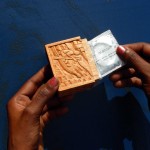
A pretty condom carrying box. By M. Sayagues
But for many others, it is not. Ads should target different segments. If we want to attract the attention of the young instead of totally turning them off, ads must be cool.
It is a fine balancing act. About three years ago, the South African anti-AIDS campaign LoveLife published a monthly insert in major newspapers, called Uncut that tried so hard to be blasé it was borderline pornographic.
There is a distance from acknowledging that young people have sex to portraying teens dressed like hookers in positions suggesting group oral sex. Many parents threw Uncut straight away. My daughter, aged 14 then and no prude, thought it cheapened girls.
After many complaints and public debate, Uncut changed. It went overboard. Now it reads like a church teen newsletter, wholesome and boring.
It may be that the terrifying scale of the AIDS pandemic in Southern Africa inhibits ad campaign planners and donors from portraying safe sex as fun. Maybe it is fear of offending churches, politicians and parents. And talking about sex has traditionally been taboo.
Yet, to get young people to practice safe sex, condoms must become part of their sexual paraphernalia and discourse. A bit of humour helps.
So have a laugh and tell us which is your favourite!
Ad selection courtesy of Chris Well, a designer and sexual rights activist at Conversations for a Better World. Check out his website for teens and reproductive health: www.15andcounting
The UN has finally decided to stand up for women! A decision to create a new agency for women was taken by the General Assembly on September14.
Our colleague Thalif Deen, IPS bureau chief in New York, was the first and only journalist to report it for the [...]]]>
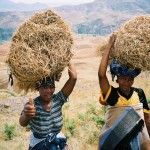
A breakthrough for us as well? M. Sayagues
The UN has finally decided to stand up for women! A decision to create a new agency for women was taken by the General Assembly on September14.
Our colleague Thalif Deen, IPS bureau chief in New York, was the first and only journalist to report it for the first several hours.
But this blog is not to crow about our scoop.
I’m quite excited by the prospect of a new women’s agency with money and political power. No longer will the world’s feminists have to lobby from the outside to put their views on the table. They have now won admission to the high table.
Any one of those bright, articulate, activist women can emerge to lead the agency. The reality is likely to be less rosy. But chances are that, because it’s new, it will be less under the thumb of the old boy network.
You think I’m a romantic? What the hell, there is no harm in dreaming, is there? I like to think that there was no way that the General Assembly could have once again shelved the plan for a new women’s agency.
It’s 14 years since Beijing. All the small and big things that governments were forced to accept around women’s rights (CEDAW, MDG, etc.) made it impossible for any country to block the efforts of myriad initiatives (from small grassroots groups to reforms in government policies even if they started as mere tokenism) and to politicise the cause of gender equality.
I do see great hope in the increasing presence of women in politics – Liberia, Japan, India, wherever you look, even Iran (new ministers) and the Gulf (Saudi Arabia has made a few small concessions to women!).
Of course, there is a backlash too – more violence against women worldwide.
As IPS gender editor, I am sure we will keep track of the new agency as it will be a key player achieving the MDG3 goal – gender equality.
Well, hope springs eternal!
]]>
